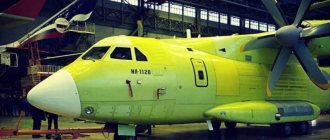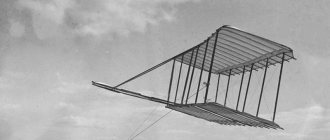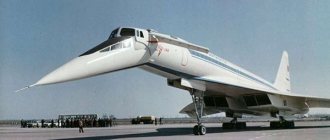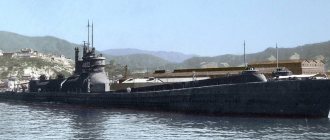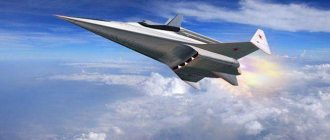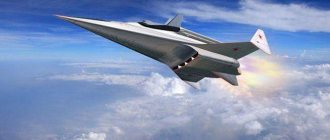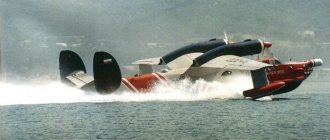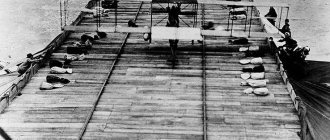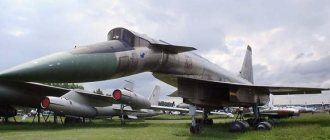The 3M strategic bomber is a modification of the M-4 with an increased flight range. On it, the AM-ZA engines were replaced with VD-7, which had 25% lower fuel consumption, 26% higher thrust and lower weight and size. The aerodynamic quality of the aircraft has increased due to the installation of a new wing of increased span and horizontal tail with improved characteristics without a transverse V, starting with the second aircraft - with a controlled adjustable stabilizer.
The wing consoles of the 3M bomber had a negative twist, the wing mechanization was similar to the M-4 type. The front part of the fuselage was rearranged, as a result it became possible to move the antenna of the RBP-4 station from under the fuselage to the nose part, extended by 1 meter, and install a receiving rod on top for refueling in flight. The crew cabin was reconfigured and working conditions were improved, and the pilots' seats were moved to a resting position.
Construction of the first prototype aircraft was completed in the early autumn of 1955. Due to the delay of the VD-7 engines, it was decided to conduct tests with AM-ZA engines. On March 27, 1956, the crew led by test pilot M.L. Gallayem made the first flight on the new machine. Then tests were carried out with two VD-7 and two AM-ZA engines due to doubts about the reliability of the VD-7. The tests were completed with fully installed VD-7 engines. During testing, additional drop tanks with a total capacity of 13,000 liters were installed under the wing of the aircraft, the maximum weight reaching 202,000 kg. Serial production of 3M aircraft began even before the tests were completed.
During testing, not a single prototype was lost. In 1959, the 3M bomber set 12 world records for altitude and payload, including lifting with a load of 10 tons to a height of 15,317 m, and a load of 55,220 kg was lifted to a height of 2 km. The plane was registered in the table under the name “201M”.
Another modification of the aircraft from OKB V.M. Myasishcheva came out in connection with the USSR government decree of August 1, 1958, ordering the creation of a missile-carrying aircraft based on the 3M aircraft. It installed advanced equipment and improved the aerodynamics of the aircraft. Externally, it was distinguished by an elongated, pointed nose of the fuselage with a rod at the end, which improved the streamlining of the vehicle. The power plant consisted of four more economical VD-7B engines. After joint tests, it was decided to replace the 3M aircraft in serial production with the 3MD aircraft. A total of 90 3M aircraft of all modifications were built, including experimental ones. In connection with international treaties, some 3M aircraft were converted into refueling aircraft.
3M aircraft modifications
3MD - serial strategic bomber;
3MS-2 - tanker aircraft;
3M-T "Atlant" - an aircraft for transporting large cargo on external dorsal mounts
The newest best military aircraft of the Russian Air Force and the world photos, pictures, videos about the value of a fighter aircraft as a combat weapon capable of ensuring “superiority in the air” was recognized by the military circles of all states by the spring of 1916. This required the creation of a special combat aircraft superior to all others in speed, maneuverability, altitude and the use of offensive small arms. In November 1915, Nieuport II Webe biplanes arrived at the front. This was the first aircraft built in France that was intended for air combat.
The most modern domestic military aircraft in Russia and the world owe their appearance to the popularization and development of aviation in Russia, which was facilitated by the flights of Russian pilots M. Efimov, N. Popov, G. Alekhnovich, A. Shiukov, B. Rossiysky, S. Utochkin. The first domestic cars of designers J. Gakkel, I. Sikorsky, D. Grigorovich, V. Slesarev, I. Steglau began to appear. In 1913, the Russian Knight heavy aircraft made its first flight. But one cannot help but remember the first creator of the aircraft in the world - Captain 1st Rank Alexander Fedorovich Mozhaisky.
Soviet military aircraft of the USSR during the Great Patriotic War sought to hit enemy troops, their communications and other targets in the rear with air strikes, which led to the creation of bomber aircraft capable of carrying a large bomb load over considerable distances. The variety of combat missions to bomb enemy forces in the tactical and operational depth of the fronts led to the understanding of the fact that their implementation must be commensurate with the tactical and technical capabilities of a particular aircraft. Therefore, the design teams had to resolve the issue of specialization of bomber aircraft, which led to the emergence of several classes of these machines.
Types and classification, latest models of military aircraft in Russia and the world. It was obvious that it would take time to create a specialized fighter aircraft, so the first step in this direction was an attempt to arm existing aircraft with small offensive weapons. Mobile machine gun mounts, which began to be equipped with aircraft, required excessive efforts from pilots, since controlling the machine in maneuverable combat and simultaneously firing from unstable weapons reduced the effectiveness of shooting. The use of a two-seater aircraft as a fighter, where one of the crew members served as a gunner, also created certain problems, because the increase in weight and drag of the machine led to a decrease in its flight qualities.
What types of planes are there? In our years, aviation has made a big qualitative leap, expressed in a significant increase in flight speed. This was facilitated by progress in the field of aerodynamics, the creation of new, more powerful engines, structural materials, and electronic equipment. computerization of calculation methods, etc. Supersonic speeds have become the main flight modes of fighter aircraft. However, the race for speed also had its negative sides - the takeoff and landing characteristics and maneuverability of the aircraft sharply deteriorated. During these years, the level of aircraft construction reached such a level that it became possible to begin creating aircraft with variable sweep wings.
For Russian combat aircraft, in order to further increase the flight speeds of jet fighters exceeding the speed of sound, it was necessary to increase their power supply, increase the specific characteristics of turbojet engines, and also improve the aerodynamic shape of the aircraft. For this purpose, engines with an axial compressor were developed, which had smaller frontal dimensions, higher efficiency and better weight characteristics. To significantly increase thrust, and therefore flight speed, afterburners were introduced into the engine design. Improving the aerodynamic shapes of aircraft consisted of using wings and tail surfaces with large sweep angles (in the transition to thin delta wings), as well as supersonic air intakes.
Tactical and technical characteristics of the 3MD bomber
– Chief designer: V. M. Myasishchev – First flight: March 27, 1956 – End of operation: March 21, 1994 – Units produced: 90
Cost of 3M bomber
– about 12 million rubles (1960 price)
3M bomber crew
– 7 people
3M Bomber Dimensions
– Length, m (without fuel receiver rod): 49.2 – Height, m: 11.5 – Wing span, m: 53.14 – Wing area, m²: 359.82 – Wing aspect ratio: 8.03 – Load on wing, kg/m²: 520 – Aerodynamic quality: 18.70
3M bomber weight
– Empty weight, kg: 76,800 – Normal take-off weight, kg: 145,600 – Maximum take-off weight, kg: 193,000
3M bomber engine
– 4 × VD-7B turbojet engines – Non-afterburning thrust, kgf (kN): 4 × 9500 (93.2) – Thrust-to-weight ratio (at maximum take-off weight): 0.2
Bomber speed 3M
– Maximum speed, km/h: 930 – Run length, m: 1700 – Run length, m: 3000
Flight range of the 3M bomber
– 11,850 km
Service ceiling of a 3M bomber
– 12,150 meters
Armament of the 3M bomber
– Small arms and cannon: 3 × 2 × AM-23 – Combat load, kg (normal / maximum): 5000 / 18 000 – Bombs, kg: 2 × FAB-9000 or FAB-5000, 6 × FAB-3000, 28 × FAB-500, 52 × FAB-250
Tu-22 M3 photo
The aircraft is equipped with two NK-25 turbojet engines, developing power with an afterburner of up to 25 thousand kgf. The power plant is controlled by the ESD-25 electrical system, and in the event of its failure, a backup hydromechanical system is provided. The aircraft's internal tanks with a total capacity of 50 thousand liters are located in the fin, center section, in the movable and fixed parts of the wing and the central part of the fuselage.
Tu-22 M3 diagram
The aircraft's combat equipment may include: three supersonic air-to-ground missiles, ten aeroballistic missiles for hitting enemy ground targets, as well as up to 12 tons of conventional or nuclear bombs located in the fuselage and on the external sling. The aircraft is also equipped with defensive weapons - a GSh-23 cannon with a rate of fire of up to 4 thousand rounds per minute. The TU 22 M3 is still in Russian service. In 2008, the aircraft successfully carried out combat missions during the war in South Ossetia, carrying out targeted air strikes on enemy bases and ammunition depots.
History of the Eurostrategist
The Tu-22M2/M3 bombers, which in the 1970–1980s massively replaced the subsonic Tu-16 and the first supersonic Tu-22B/Tu-22K in the USSR Air Force, were often called “Eurostrategists” - emphasizing that their range was insufficient for intercontinental operations allows, operating from the territory of the USSR, to attack any targets in Europe (and more broadly on the Eurasian continent and North Africa). In addition, new vehicles entered the naval missile-carrying aviation of the USSR Navy, becoming one of the two main tools in the fight against aircraft carrier groups of a potential enemy.
In total, about 500 Tu-22M2 and M3 bombers were built for the USSR Ministry of Defense, the vast majority of which went to the Russian Federation after the collapse of the Soviet Union.
Tu-22M3 takes off from Dyagilevo airfield
Photo: commons.wikimedia.org/Alex Beltyukov
In subsequent years, their fleet was greatly reduced: all Tu-22M2 were written off, in addition, naval aviation units were liquidated with the transfer of the remaining (very small) part of the Tu-22M3 to the Air Force. To date, the long-range aviation command of the Russian Aerospace Forces has, according to available data, about 70 Tu-22M3 aircraft.
"Dagger" for "carcass"
What is a Russian strategic bomber capable of with a new combat missile?
Vehicles of this type actively participated in local conflicts, from the war in Afghanistan to the operation in Syria. Moreover, the main weapons used in all these wars were free-falling bombs of various types. Missile weapons, be it supersonic anti-ship cruise missiles X-22 or aeroballistic X-15, remained in arsenals - the war for which they were created, fortunately, did not happen.
Tu-22 M3 cabin
The TU22M3 on-board equipment consists of a navigation and flight control system that allows the aircraft to automatically fly along a predetermined route, a radar targeting and navigation system, and electronic radar equipment with the help of which radar reconnaissance, jamming, warning of radar exposure, ejection of heat traps and reflectors are carried out. , an IR station designed to notify the crew of the approach of enemy missiles.
Design of Tu-22M3
According to its characteristics, the Tu-22M3 aircraft turned out to be much more powerful than foreign representatives of this class in terms of flight range, speed, and payload capacity. The secret of the machine's design lay in the structural features of the swept wings, which are capable of changing their geometric shape. The aircraft wing consists of a fixed part and tail made of light aluminum alloys. The tail elements change their direction depending on the speed of the vehicle.
The lightweight design reduces the empty weight of the machine while increasing its carrying capacity.
Engines
Powerful new generation engines are capable of producing colossal power. Piloting of the bomber is carried out using an electrical supply system or hydromechanics when the former fails. Fuel tanks are located in different places throughout the aircraft body. One flight hour of the Tu-22M3 requires 51 man-hours of engineers and equipment.
Cockpit
The cockpit is equipped with a developed set of equipment. The piloting and navigation complex allows the vehicle to independently reach a given route point. The aircraft contains a radar station and an electronic jamming system, which are responsible for reconnaissance activities, jamming and notification if the vehicle is detected by radars. The infrared station is designed to detect the approach of missiles to the aircraft carrier.
Externally, the Tu-22M3, photos and videos of which are publicly available, impresses with its power, smooth movement and the structure of the wings and hull.
Combat complex
The aircraft's combat complex can include three air-to-ground missiles, ten ballistic missiles designed for ground targets, and conventional or nuclear bombs weighing up to 12 tons. In addition, the vehicle is equipped with a rapid-fire cannon designed to serve for the defense of the aircraft carrier.
The aircraft is equipped with powerful lighting equipment. The bottom of the body is painted white, and the sides and top are painted gray and green. This is a kind of camouflage to improve the stealth of a missile carrier. In the 1990s, painting the sides in the form of bright, intimidating figures became popular among crew members.
To monitor the flight status, flight recorders and video recording equipment are installed on board. All aircraft are necessarily equipped with a system of voluntary and forced ejection, which is carried out in an upward direction with a protective helmet on the face. The plane leaves in the following order: operator, navigator, pilot, commander. The decision to force ejection is made by the ship's commander.
For departure from the cabin over the water surface, there is an inflatable boat with a supply of necessary medicines and food.
The aircraft is equipped with a modern air conditioning and air purification system and fire extinguishing equipment. The presence of this equipment is vital in conditions of combat missions and exercises at supersonic speed.
IL 78 tasks
The creation of the Il-78 aircraft was dictated by the urgent need to provide fuel for aircraft of various classes and types: heavy bombers Tu-95MS and Tu-160, tactical aircraft MiG-29SMT, MiG-31B, Su-24M, Su-27IB, Su-30 and Su-35, anti-submarine aircraft Tu-142, long-range radar patrol, detection and guidance aircraft A-50, as well as other existing and promising models.
The introduction of IL-78 made it possible to solve strategically important problems:
- ensure uninterrupted supply of aviation in remote regions;
- increase the mobility and maneuvering of combat formations between regions and deployment points;
- deliver fuel in a short time;
- carry out the movement of cargo and personnel.


